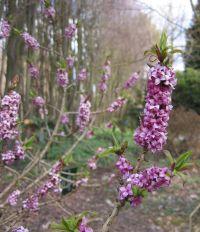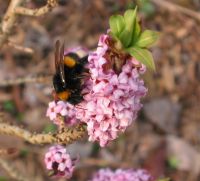Mezeron, Paradise plant - Daphne mezereum
English name:
mezeron, paradise plant
Scientific name:
Daphne mezereum
Family:
Thymelaeaceae (mezereum)
Height:
2 m.
Flowering:
March to April
Range:
Europe and western Asia to Altai
 |
|
 |
 |
The 28 year old Daphne mezereum in the picture is from seed collected in the wild in the Tatra mountains in the Czech Republic in 1977. It can be found about 3 meters to the left as you enter the main gait to the Arboretum: square 917 position 1011
Plant description:
The genus Daphne is estimated to contain 50 species, all coming from Europe and Asia. In our collections we have only one living species, Daphne mezereum although 19 different species have been tried over the last 70 years. We have 11 specimens of this months plant including two in the Forest Botanic Garden in Charlottenlund. Five of these are documented, wild-collected plants which make them valuable for research. Our wild collected specimens come from Czech Republic, Slovakia and Finland.
Daphne mezereum was first noted in Denmark in the 1400s. S. Ødum reports no evidence of fossil plants and concluded that it was probably a very early introduction which has become naturalized in some areas. This is not unlikely as it has long been used as a medicine plant. Individuals of this species is not long-lived. The Arboretums oldest living specimen is from 1977. The species name mezereum derives from the species old Persian name, mazeriyn which is derived from the word to kill.
Daphne mezereum is a deciduous bush in Denmark. The bark is light grey-brown with a strong smell when fresh, especially the inner-bark. Leaves are alternate, without hairs and with entire margins. They lanceolate and are broadest above the midpoint. The flowers have four petals and are light red or red-violet in colour. They open out before the leaves spring out and a few can be seen to open in mild period in January. The flowers have a strong perfume. The fruit are single seeded and are strongly red in colour. They are deadly poisonous but because of their fiery-peppery taste few people eat enough to die. But note that 10 berries is enough to kill a grown man. The bush is rare if public parks because it is poisonous. The berries and bark have been used in medicine.
Some cultivars are known and a white flowered form is reported to produce mostly white flowered progeny from seed. Because of a virus problem that is not transmitted by seed it is recommended that one uses seed plants and not the cultivars which are made by cuttings.
The early, nicely perfume and attractive flowers along with the striking red berries make this a desirable garden plant. However, it suffers from too dry conditions and as mentioned above is strongly poisonous.
References:
Bean, W.J. 1973 Trees and Shrubs Hardy in the British Isles Vol II. D-M.Bean and Murray publishers. 784 pp.
Lange, J. 1994. Kulturplanternes Indførselshistorie i Danmark. (Introduction History of Cultivated Plants in Denmark). Jordbrugsforlaget, Frederiksberg. 458 pp.
Mabberley, D.J. 1998. The Plant Book. The Bath Press, Bath, 858 pp.
Møller, P.F. & Staun, H. 2001. Danmarks Træer og buske. Politikens Forlag A/S, Copenhagen, 336 pp.
Olsen, O. et al. 1997 Havens Planteleksikon. Træer og Buske. (Danish Plant Encyclopedia, Trees & Bushes). Det Danske Haveselskab Publisher, 674 pp.
Poor, J.M. & Brewster, N.P. 1996. Plants that Merit Attention. Vol II. Shrubs. Timber Press Publisher.363 pp.
Ødum S. 1968. Udbredelsen af træer og buske i Danmark (The Distribution of trees and bushes in Denamrk). Botanisk Tidsskrift 64:1-118
